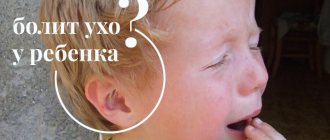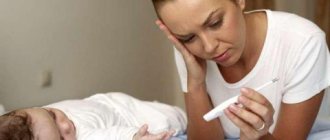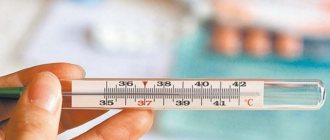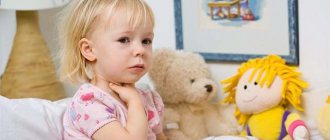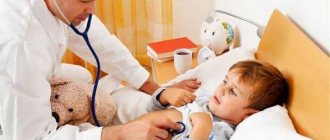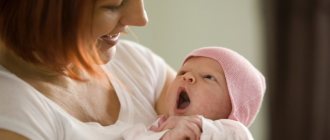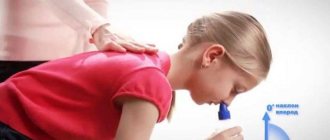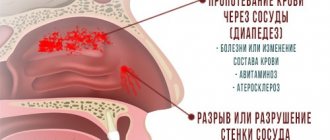What is a cold and how does it appear?
In fact, such a term does not exist in medicine, since a cold is a collective concept, which is understood as a set of diseases of an infectious nature that have similar symptoms. Typically, a cold means acute respiratory viral infections and acute respiratory infections; it is also often called the flu. In any case, regardless of the cause of the cold, you cannot ignore it. Like all infectious diseases, it requires a careful approach to the treatment of colds in children. This is due to the fact that colds can seriously weaken the immune system and lead to various complications, especially in young children.
A cold can be caught at any time of the year, but the largest number of cases is traditionally recorded in winter and during the off-season. This is due to the fact that it is during these periods of time that the human body is most weakened due to a deficiency of vitamins and microelements. The high risk of hypothermia also contributes.
You can become infected with ARVI or acute respiratory infections either through direct contact with a sick person or through indirect contact - through surfaces, by touching various objects, or shaking hands. Direct penetration into the body occurs through the mucous membranes. And here we mean not only the mucous membrane of the larynx and nose; the virus can also be transmitted by rubbing your eyes. Once the infection enters the body, it spreads throughout the body through the bloodstream. The speed of spread depends only on immunity. If macrophages (“sentinel” cells of the innate immune system, which are the first to respond to pathogenic microflora and viruses, destroying them and giving signals to activate the immune defense) quickly come to work, then the patient may not even notice the symptoms - a strong immune system can suppress the infection. Otherwise, when the immune system is weakened, the disease can last up to 7-10 days or more, taking an acute form.
Types of colds in children
One of the most difficult infections is influenza. Manifestations of the disease are very diverse: it can be a high temperature, a sore throat, pain in the joints, a cough, a runny nose.
Rhinovirus is the name given to the virus that causes the common runny nose (runny nose). If the child feels tolerable, his temperature is normal, but his nose is running, apparently we are dealing with a runny nose. The nasal mucosa is mainly affected, and the baby loses sensitivity to odors.
Adenoviral infection most often enters the body through the upper respiratory tract, less often through the intestines and eyes. Its main symptoms are elevated body temperature, sore throat, redness of the throat, and enlarged cervical lymph nodes.
Parainfluenza is a type of acute respiratory viral infection. When an infection of this type enters the body, the voice usually becomes hoarse or hoarse, and a cough may occur.
You can eliminate the effects of the virus by drinking warm milk to the baby, or by performing steam inhalations, gargling with a decoction of medicinal herbs that reduce dry cough. In children, parainfluenza is dangerous due to the appearance of false croup.
Classic cold symptoms in children and adults
Most often, the first signs of the disease appear a day or two after infection. Patients usually complain of the following unpleasant symptoms:
- nasal congestion, mucus discharged from the nose may not only be transparent, but also have a yellow or even greenish tint, indicating a bacterial infection;
- increased body temperature and resulting fever;
- painful sensations in the throat, a cough may appear over time;
- sleep disturbance, poor appetite, general deterioration of health, irritability.
Often, when a patient has a cold, the mucous membrane of the throat swells and turns red, which is why the disease can be confused with a sore throat. At the same time, the cervical lymph nodes enlarge. Therefore, to make a correct diagnosis and choose an effective method of treating colds in children, you need to consult a doctor.
Symptoms of the disease usually last no more than 7 days. If colds in children are treated in a timely manner, the child usually recovers well, without any complications.
When you need to immediately call an ambulance for a child:
- increase in body temperature to 39-40 degrees:
- it is not possible to reduce the high temperature for a long time;
- the child experiences confusion and fainting;
- severe difficulty breathing;
- blue discoloration of the skin;
- vomiting, diarrhea.
The sooner medical care is provided to the baby and treatment is prescribed, the lower the risk of negative consequences for his body.
Signs of a cold in a child
Published: October 20, 2018
A cold is a disease that is familiar to every mother, and every mother needs to be able to identify the signs of a cold in a child in order to prevent the disease. Colds accompany us all our lives, and although a cold is a disease associated with hypothermia, we habitually apply this word to all respiratory infections. For the most part, various colds are completely harmless diseases that go away within a week at most and do not cause much concern, except that the signs of a cold in children are quite unpleasant.
Many people know how not to infect a child with a cold, but, nevertheless, children get sick. What is the most important thing in treating a cold? This is timeliness. If you do not treat a cold, thinking that it will go away on its own, you can get a wide variety of complications. Treatment of a cold in a child must begin with the appearance of the very first symptoms, and since all children are different, the signs of a cold in children may be different.
Why are colds dangerous for children?
Some parents sometimes do not attach importance to the seriousness of colds, believing that the child’s body can always cope with a viral infection on its own. In fact, even a common runny nose should be considered a warning sign, since in children the condition can quickly get worse, worsening within a few hours. Therefore, even with a mild cold, treatment should be started immediately, and not wait until the baby recovers on his own.
If you ignore this requirement, then secondary bacterial infections may join the main disease due to weakened immunity. In most cases, the following can develop against the background of colds:
- Otitis is an inflammation of the ear; it usually appears when ARVI progresses within three days. Symptoms of acute otitis media include fever, congestion, or ear pain.
- Bronchitis - due to a cold, obstruction (narrowing) of the bronchial passages quite often occurs, which leads to deterioration in breathing. A characteristic sign of bronchitis is wheezing when breathing and coughing. In addition, if a child has asthma, then as a result of a cold it worsens, attacks become more frequent and more serious.
- Sinusitis is a disease caused by a bacterial infection of the maxillary sinuses. As a rule, we can talk about sinusitis if a runny nose after a cold persists for two weeks or more.
- Pneumonia is an inflammation of the lungs resulting from the development of a bacterial infection in the respiratory tract. Pneumonia can be recognized by several signs. For example, if after three days the symptoms of a cold do not disappear, and rapid breathing, severe cough are added to them, and the high temperature continues to persist.
In addition, a prolonged cold can have a negative impact on all internal organs and systems, including damage to the heart and blood vessels, liver, and kidneys.
The described complications require a different approach to the treatment of colds in children. Therefore, in the first stages, as soon as you notice a deterioration in the baby’s condition, you must definitely consult a doctor so that he can prescribe the correct treatment for the cold. Thanks to this, the disease will proceed in a milder form, and the child himself will recover faster.
How to treat a child at the first signs of a cold?
A caring mother knows how important it is to prevent colds in children. Parents remember the benefits of sports, walks in the fresh air, and strengthening the immune system. But children can still get sick. Most often they suffer from a cold. This usually refers to viral infections. It is believed that children who go to kindergarten can get sick about 10 times a year. This figure is very arbitrary, but it suggests that parents should be prepared for ARVI in their children. It is important to know how to treat your child at the first sign of a cold. Timely assistance will make it possible to prevent the disease from progressing, and prompt action will help a speedy recovery.
How to treat the first symptoms of a cold in a child?
To prevent the development of the disease, you need to notice the signs of a viral infection in time. These include:
- nasal congestion, which will later develop into a runny nose;
- the baby complains of a sore throat, cough, and the throat may be red;
- frequent sneezing;
- enlarged lymph nodes;
- the appearance of herpes rashes;
- temperature increase.
Even before these symptoms appear, the baby may complain of headaches and fatigue. If the mother suspects that the baby is sick, she needs to take action. On the very first day of a child’s cold, measures must be taken, and the doctor must determine how to treat it. The choice of drugs will depend on the type of virus that the baby is infected with. The following recommendations will help parents:
- give the baby a drink, for example, tea with honey, fruit drink, rosehip decoction;
- let the baby eat more vegetables, fruits, and fermented milk;
- it is worth limiting fatty and sweet foods;
- the nose should be rinsed with saline solution or ready-made pharmaceutical preparations;
- carry out wet cleaning, ventilation;
- bed rest is required.
Vasoconstrictor drops should only be used if breathing is very difficult.
It would also be a good idea to steam your child’s feet, especially after hypothermia or a winter walk.
Treatment of the first symptoms of a cold in children sometimes requires medication. Antiviral medications may be needed. These include Remantadine, Arbidol. They also use drugs that have an immunomodulatory effect, for example, Anaferon, Viferon, Laferobion.
The temperature is brought down with Panadol, Efferalgan, Nurofen. But you should not give medications if the readings on the thermometer do not reach 38°C. Treatment of a child at the first signs of a cold will be facilitated by taking ascorbic acid. If the condition worsens, be sure to notify the doctor.
WomanAdvice.ru
How to relieve a cold
Once pathogens enter the body, they begin to damage healthy cells. As a result of the activity of viruses, toxins are deposited in tissues and organs. They are the ones who cause a feeling of weakness, aches, and pain throughout the body. To free your body from them, you need to drink as much fluid as possible. Drinks with a high content of vitamin C have a particularly good treatment effect for severe colds in children. It resists cell destruction, helps strengthen the immune system, and increases the vitality of the body.
The patient is recommended to remain in bed for at least the first 2-3 days, when the immune system is in the active phase. Therefore, you should not force a sick child to go for a walk against his will, or try to cheer him up by offering active games.
Creating a comfortable home environment so that the child has fewer reasons for irritation deserves special attention.
If the disease is accompanied by a cough, then you can use aroma lamps with essential oils, which will simultaneously soften the baby’s mucous membranes and at the same time destroy pathogenic bacteria in the air. In addition, it is worth taking care of additional air humidification in order to prevent further injury to the mucous membrane of the larynx, which, among other things, is the first barrier to airborne infection in the body.
Don’t forget that the room needs to be regularly ventilated and wet cleaned daily. Thanks to this, it will be possible to create air circulation and reduce the concentration of pathogenic microorganisms. If the baby shows positive dynamics of recovery, then walks in the fresh air are especially recommended. True, if the weather permits (no rain, slush, strong wind).
Frequent rinsing of the nose and throat should not be written off either. Thanks to this simple action, it will be possible to clear the nasal passages of mucus and thereby make it easier for the baby to breathe. Also, rinsing your nose will moisturize the mucous membrane and prevent it from drying out. Irrigation is especially recommended after walks in order to remove harmful microflora from the nasal cavity, and before using nasal drops, thanks to this the medicines will go directly to the mucous membrane and be better absorbed.
How does a cold start in a child?
Usually, the first sign of a mother’s illness is considered to be an increase in temperature; a cough and runny nose may appear on the second day after the onset of the illness or even later. Although colds often begin in a different scenario. First, a sore throat may appear, then the eyes begin to water, and a runny nose appears, and a rise in temperature comes later. This course of the disease is also very common.
But all these signs of a child’s cold indicate that the disease has already settled in the baby’s body and is progressing. How can you find out about the approaching disease before the familiar signs of a cold in children appear? In fact, the baby’s body gives you signs even before the acute period of the disease begins. If a child suddenly becomes capricious, be sure to analyze what is the reason.
If the baby is not hungry, slept well, is not tired and nothing, including a wet diaper, upsets him, but is in a bad mood, it is quite possible that a cold is already taking root. If, against the background of a bad mood, lethargy, decreased appetite, and drowsiness appear, then, most likely, tomorrow there will be other signs of a cold. Thus, colds can also be detected in children under one year of age, who cannot yet tell what is bothering them.
If you notice similar symptoms in your baby, you should immediately organize a regimen of reduced physical activity and plenty of drinking. It’s best if you turn on his favorite cartoons or read an interesting book together. For older children, you can offer quiet activities, such as assembling grooves, drawing or any handicraft. It is better to use the most common compote as a generous drink.
The next day, other signs of a cold in children will certainly appear. This may include a cough and runny nose, as well as red eyes and sneezing, sore throat or headache, lethargy and body aches, lack of appetite, sometimes with vomiting and diarrhea. The temperature also usually rises. In each specific case, one or several symptoms may be observed simultaneously.
Treatment of colds using traditional methods
The main therapy to eliminate cold symptoms should be prescribed by a doctor, and this is a prerequisite for a speedy recovery. However, if the baby’s health allows it and he does not have concomitant chronic diseases or allergies, then the main course of treatment for colds in children can be supplemented with folk remedies.
For example, at a high temperature, so that it sleeps faster, it is recommended, in addition to taking medications, to wipe the body with a towel soaked in cool water. This will help alleviate the baby’s condition.
Another way to fight viruses is to drink warm drinks frequently, and at night you can give your child hot tea with herbs: chamomile, echinacea, coltsfoot, linden, strawberry, currant or raspberry leaves. After this, it is recommended to wrap the patient in a warm blanket so that he sweats thoroughly. Toxins are also eliminated with sweat, which contributes to a speedy recovery and relief of the patient’s condition.
Some berries have beneficial properties. For example, cranberries, lingonberries, sea buckthorn, and raspberries are rich in vitamin C, which helps strengthen the child’s immunity. It is best to prepare infusions and decoctions based on them. To do this, you will need to pour boiling water over one glass of fresh or frozen berries and leave for 12 hours, tightly wrapped. Thanks to this cooking method, more vitamins are retained in the berries.
Another traditional food that helps get rid of colds is honey. It can be added to warm drinks, made tea with it, used in fruit drinks and decoctions. You can also prepare a useful folk medicine for sore throat and cough from honey and black radish juice. It is enough to grate the radish on a fine grater, squeeze out the juice and mix it in equal proportions with honey. Just before this you need to make sure that the baby is not allergic to honey.
Prevention
If a child often catches colds, it is necessary to take preventive measures. First of all, you should visit specialized specialists to identify foci of chronic infection.
This is done by dentists and ENT doctors. Often, the inhabitants of the oropharynx or nasopharynx provoke constant exacerbations of chronic pharyngitis, tonsillitis or adenoiditis. Sometimes carious teeth are also a source of infection.
To sanitize these cavities, it is usually enough to carry out a bacterial culture to determine the sensitivity of bacteria to antibiotics and, if the growth of cultures is detected, prescribe the appropriate drug.
In addition, along with drug treatment, it is important to take care of increasing nonspecific immunity - hardening the child.
Hardening
Hardening allows you to achieve the following effects:
- Strengthen the body's nonspecific defenses.
- Increase resistance to viral and bacterial infections.
- Reduce the frequency of colds and acute respiratory viral infections or alleviate the course of these diseases.
Hardening may include various activities. This could be wiping with cool water or dousing with cold, contrast shower. You should always start with simple things. Sometimes it is enough to put on one less layer of clothing for children so that the body begins to more actively resist infections. Parents should know that hardening measures are appropriate only when children are healthy. In addition, you should not strive for impressive results in a short time. Typically, such tactics only worsen the child’s health.
Increasing nonspecific protection is a smooth process, taking into account the concomitant somatic pathology of the child, his temperament and developmental characteristics.
Effective hardening is impossible without properly organized temperature and humidity conditions in the room.
Temperature and humidity mode
It is a well-known fact that adequate temperature and humidity in the nursery affect the course of colds and acute respiratory viral infections. If a child is accustomed to coolness from birth, his body will not begin to react violently to changes in weather.
Humid air in the room prevents the mucous membranes of the mouth and nose from drying out, which increases the effectiveness of nonspecific protection - lysozyme and local class A antibodies.
A temperature of 18–20 degrees and a humidity of 60–70% allow the immune system to work fully and fight infections.
But sometimes these measures are not enough and you have to resort to medications.
Drug prophylaxis
Despite the fact that drug prevention of ARVI and colds is used quite widely, its effectiveness remains questionable. Why is this happening?
Very often, to reduce the incidence of ARVI, pediatricians and therapists prescribe antiviral drugs. However, large-scale studies have not confirmed their effectiveness; in most cases, the effectiveness of such drugs is comparable to placebo.
Such popular antiviral agents as Arbidol, Amizon, Amiksin, Groprinosin, Anaferon do not have an evidence base. Their use for frequent colds in a child in most cases is pointless.
Also, in order to increase local immunity, doctors can recommend drugs containing lysates of the most common pathogens. These medications are known by the following names:
- Bronchomunal.
- Broncho-vax.
- IRS 19.
- JOB baby.
Their effectiveness is also not confirmed in many studies, but practicing doctors often note a decrease in the incidence of acute respiratory infections during such therapy. In some situations, vaccination can help a frequently ill child.
Vaccination
Administration of a vaccine protects against one specific pathogen. But often diseases of the respiratory system are provoked by Haemophilus influenzae. It can cause the development of recurrent otitis media, bronchitis or pneumonia.
Vaccination against this microorganism reduces the incidence of such pathologies, and ordinary acute respiratory viral infections occur in children without severe complications.
Flu vaccination allows frequently ill children to avoid this dangerous disease. And, given the inhibitory effect of this virus on the immune system, it is an indirect preventive measure against other infections.
Frequent colds and acute respiratory infections require constant medical supervision of children, lifestyle changes, and taking medications if necessary. In addition, parents should know that a sick child can return to the children's group only after a complete recovery, otherwise the disease will constantly recur and the immune system will weaken.
Treatment of colds with pharmaceutical products
The main emphasis in treating colds in children, however, should be on taking special medications. In this case, doctors usually prescribe several drugs at once: directly to relieve and alleviate symptoms and to fight the virus.
Depending on the patient's condition, he may need:
- means to reduce fever and eliminate headaches;
- cough medicines and to reduce sore throat (usually syrups and suspensions, as well as sprays with an antibacterial effect are recommended for young children);
- nasal drops to relieve a runny nose and ease breathing;
- antiviral drugs in various forms.
The exact dosage and treatment regimen for colds in children is developed by the doctor. At the same time, mothers need to be careful when buying medications at the pharmacy, be sure to read the instructions, study interactions with other medications, pay attention not only to the permissible dosages, but also to possible side effects.
To protect the family and prevent secondary infections, many doctors include the antiviral drug Derinat in the standard treatment regimen for colds. This remedy is suitable for both adults and children from the first days of life.
The popularity of Derinat drops and spray is due to their effect. In particular, the drug simultaneously solves three key problems:
- fights viruses and promotes their destruction, activating the activity of macrophages;
- strengthens the body's own defenses;
- restores the mucous membrane of the nasopharynx - the first and most important protective barrier, thereby reducing the risk of secondary infection and the development of complications.
The advantage of the drug Derinat is that it is produced in a compact and most convenient form. Drops are especially suitable for children, and spray for adults and children over 3 years old. Thanks to this dosage form, the active substance immediately reaches the source of infection and quickly starts working without loading the digestive tract. The instructions describe in detail dosage regimens for the treatment and prevention of ARVI.
Treatment of colds in children
As a rule, colds in children occur without complications, but only when the disease is detected on time and proper treatment is provided. Only in this case will the result be desirable for the parents.
Children are most defenseless against colds in the cold season; in summer, the disease rarely occurs. The slightest temperature difference can provoke it. A child may drink cold juice or eat ice cream, get his feet wet, get hot and run out of the house. Two minutes is enough and the pathogenic microbes that provoke the disease will begin their work.
People say that a cold can be cured in seven days, but if you don’t touch it, it goes away on its own in a week. Parents perceive the fact that their child has a cold differently; some trust folk remedies, while others solve the problem by going to the pharmacy.
They all need to understand that the best way to treat a cold is without aspirin. If the baby’s body temperature does not rise above 38 degrees, you should not rush to bring it down, since this is the body’s natural means of self-defense and its presence indicates the mobilization of all systems to fight the infection.
The temperature should be reduced if it exceeds the specified mark of 38 degrees. A good folk remedy is water with vinegar; it is perfect for wiping a baby. To prepare the product, you need a liter of water and one tablespoon of 6% vinegar. The child's chest and back are first wiped, then the arms and lower body. You can apply a compress to your forehead. Such rubdowns should be carried out every one and a half to two hours, and the underwear should be changed if the baby sweats.
Treatment of colds in children does not allow the use of large amounts of antipyretics. You cannot give too many medications at once and it is important to follow the dosage.
You should not get carried away with drops that constrict the vessels of the nasal sinuses. If taken for five to six days, atrophy of the nasal mucosa may occur.
Inhalation is also effective in the treatment of colds in children, but you should not get carried away with scented products if the child has allergies - this can cause bronchospasm and make breathing difficult.
Frequent colds in children
Colds in children occur frequently due to the immaturity of their immune system. Thus, the immune system is trained and adapted to environmental conditions and the infections present in it. This is a completely natural process provided for by nature itself. From early childhood, a person is exposed to bacteria and viruses, acquires immunity to them, and then does not get sick in adulthood. In reality, this is what happens: a person often suffers from acute respiratory viral infections in childhood, and subsequently, as they grow older, less and less often.
What not to do if you have a cold
When a child gets sick, some parents begin to show overprotection towards him, protecting him from everything and everyone. He really needs isolation and limiting contacts, but there is no need to go to extremes in this matter. If a child wants to play with adult brothers and sisters or communicate with relatives, it would be much more effective to ask them to wear a medical mask so that they do not become infected. It is also good to start taking antiviral drugs in a timely manner to prevent the disease, as well as observe basic rules of personal hygiene. This will be quite enough to prevent the spread of the disease within the family.
In addition, there are a few more recommendations on what not to do when your child has a cold:
- wrap him in warm clothes - you should always dress your baby according to the weather; if he is indoors, then perhaps it even makes sense to take off some clothes so that his body can breathe (this will help to quickly get rid of the high temperature);
- force them to eat - during a period of illness, all the forces of the immune system are devoted to resisting infection, and digesting food takes away valuable resources, it would be better to increase fluid intake and feed the baby something light when he asks for it;
- give antibiotics without a doctor’s prescription - self-treatment of colds in children with antibacterial drugs will not have the desired effect; on the contrary, it will only do harm, further weakening the immune system;
- putting mustard plasters on, steaming your feet - doing this at high temperatures is strictly prohibited, as this can only aggravate the situation and accelerate inflammation.
Colds in children under one year of age: what to look for
Usually, colds in children under one year of age cause concern among both parents and pediatricians. A baby at this age does not yet know how to blow his nose and cough. Considering that the child cannot cough, such children should not use expectorants, which increase the amount of sputum, without the doctor’s recommendations.
Despite the fact that colds in children under one year of age are a dangerous disease, with proper radiation and care everything goes away without negative consequences. But, of course, all mothers dream that the baby does not get sick and wonder how not to infect the child with a cold if it has already appeared in the house.
